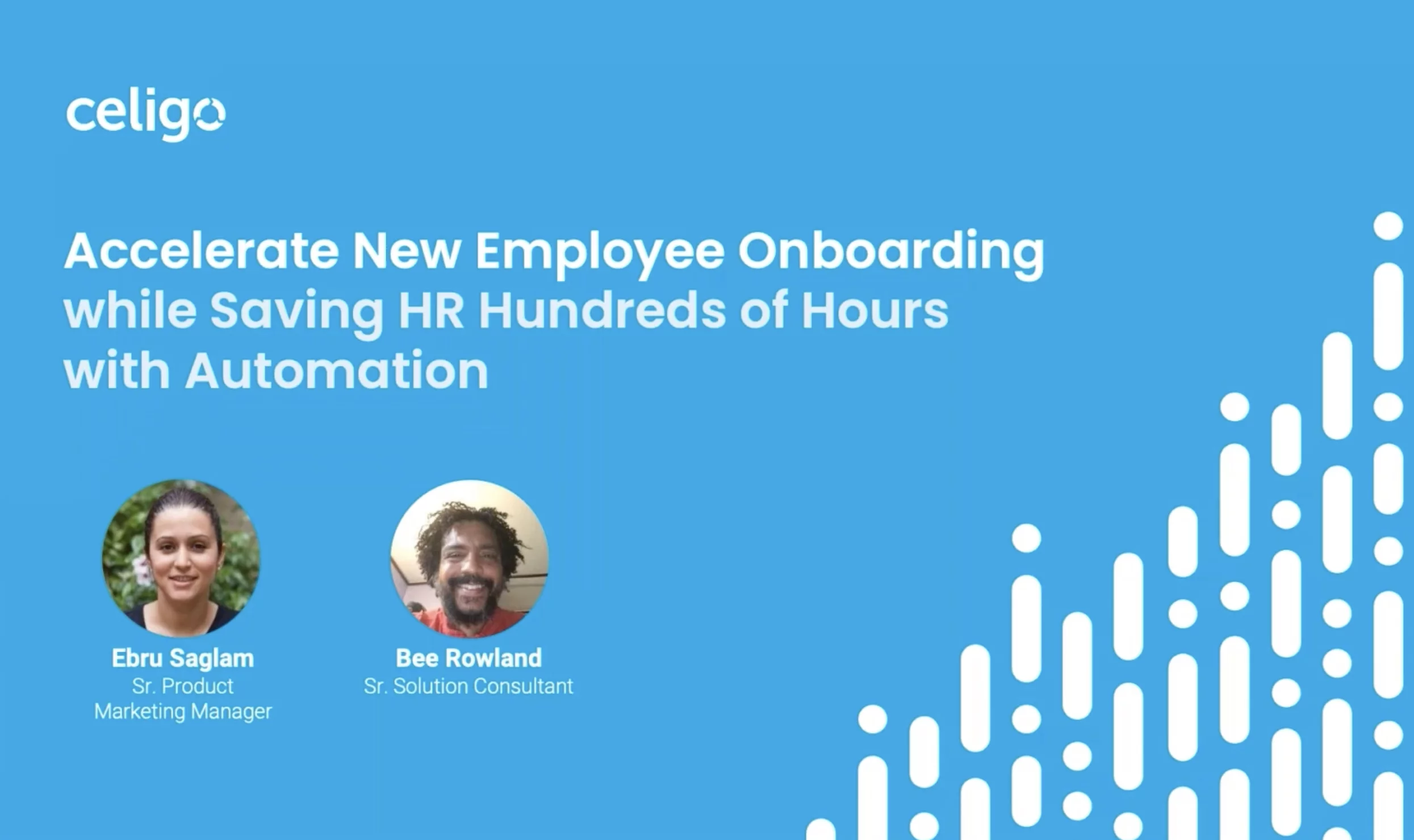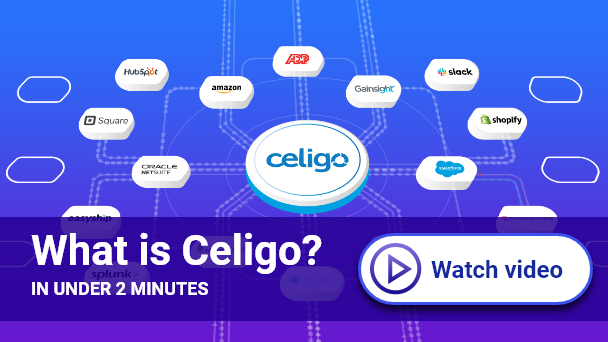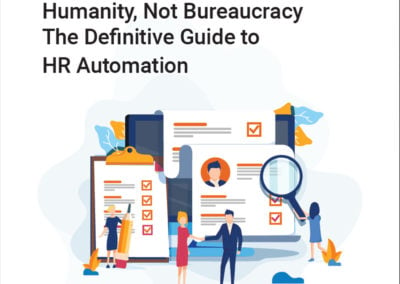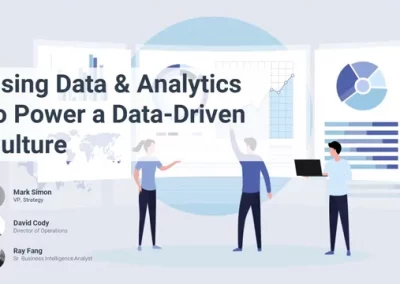Full Webinar Transcript
Okay, let’s get started here. Hello, everyone. My name is Abru and I’m a product marketing manager at Celigo. So this week we’re hosting a series of virtual events for our new business process automation products. And this is the first event in the series. So I am happy to kick things off by introducing our new employee onboarding and off business process automation for ADP. So in this event, you’ll learn how to accelerate new employee onboarding and off-boarding while saving HR hundreds of hours with automation. And I’m here today with our business process automation expert, our senior solution consultant, Bee, and Bee will walk us through the new product, and at the end of his demonstration, we’ll be sharing a special promotion, which is only valid for today’s event attendees. So stay tuned until the end. And we will also have a Q&A after Bee’s demonstration. So if you have any questions during the presentation, type them in the questions pane, and we’ll be answering them during the Q&A. So, yeah, for those of you who are not familiar with Celigo, here’s a quick overview. We are an iPassS integration platform as a services company. And we have 6 offices across the globe with more than 450 employees and today we have more than 4,000 customers. And some of these are very well-known brands. You can see the logos here. And at any moment our customers are automating more than 40,000 business processes on our platform, and every month we process more than six billion records again on our platform. And we are also highly rated on industry’s most popular review sites, such as G2, Gartner, Salesforce, FXchange, and some others. So, yeah, you may be thinking why more than 4,000 customers chose Celigo, and one of the reasons is that our platform is built for not only IT but also with the business users in mind. So Celigo automates business processes across the entire organization. But that’s not the only thing. So unlike any other integration platform out there, we actually go beyond integrate anything to anything. We automate and optimize complete business processes end to end with embedded business logic. So what that means is best practices based on learnings from the automation of thousands of other customers and recommendations from software vendors, they are all built into the products so that when you want to automate the business process, you don’t have to figure out how to start, where to start or what your ideal workflow should be. And you also don’t have to be a business process expert. So we have everything built-in for you. And we are the only iPassS to do so. So the platform helps accelerate your digital transformation, and it empowers you to easily automate any business process within your organization. So you can either build your own business process automation, or use our managed customizable and pre-built business process automation to get us started. And so now let’s talk about employee onboarding and off-boarding. So beyond increasing operational efficiency, productivity, saving time and money, there is another reason to why you should care about automating this business process. And so one research found out that new hires with effective onboarding had 62% better time to productivity. And they were able to start contributing sooner within their new role. So what does this mean for your business? Now, if you’re a growing company and you’re short on resources so you don’t want to just hire new people fast, but you also want them to start contributing immediately because that is how you will support your company’s growth. And so if you are a CFO, a CEO, or a COO, automating the employee onboarding and offboarding should be part of your growth strategy and this should be your ultimate goal with automating employee onboarding reaching that 62% better time to productivity with effective onboarding. So now let’s take a quick look at this process and see what happens when a new employee is hired. So first, a new hire is created in a master HR system such as ADP, and then their records are created across multiple other apps to give them access to all the tools they need and that over time– so these employees most likely they’ll also need access to other apps. And again, they will be given access to more. And once they leave, they will be deprovisioned across all the apps they gained access to in the first place. And as you see, this is a series of very repetitive, mundane, error-prone, time-consuming tasks for HR operations. And so how does all of this really impact HR and your organization? So what is keeping HR up at night? And so here are some questions to ask yourself. So as hiring accelerates, can your HR team scale their operations to support the growth of the organization, or does HR end up being a bottleneck? And then so what happens when employees don’t get access to the right tools instantly? Can they support your company’s growth objectives, or are the new hires now becoming the bottleneck? And similarly, I mean, as important is the deprovisioning piece. Right now, are you confident that your teams can ensure timely offboarding the employees that leave your organization? Or are you in constant stress that these employees can cause potential financial or IP or data related risks caused by incomplete offboarding processes. Now, having said that, the good news is that you no longer have to worry about any of that stuff, so we took care of everything for you and we built something to automate employee onboarding and offboarding for you. And we build it in a way that the whole process is now easy to manage, not just for IT, but also for HR teams. So we knew building point-to-point integrations between ADP and other applications like ADP and Salesforce, ADP and Zendesk and that expecting our customers to install and manage multiple integrations was not going to be the ideal solution. So with this in mind, for the first time as Celigo, we created the Celigo Business Process Automations. So these are pre-built integrations, and they can capture beyond point-to-point integrations, and they can automate key processes between a hop application and multiple destination applications through a single pre-built automation. And so here is the brand new employee onboarding and offboarding business process automation for ADP. So in this case, as you see in the diagram here, ADP acts as the hub and the source of truth, and then the automation ensures data accuracy between ADP and all these selected destination applications. And so any app you see on the left here is prebuilt into it in the automation, but then you can also customize and include more destinations based on your business needs, and you don’t have to figure out the workflows needed for the provisioning or the provisioning. So we already know that as Celigo, the steps required for provisioning across Zendesk and Github are not the same. So we know records to update are not the same and then we built these as best practices so that you don’t have to do any guesswork and even non-business process experts can automate this process through this automation. And so with automation like delays are no longer a problem, everything happens instantly. The minute a new hire record is created, then in ADP, they can get access to all the tools they need. And also a risk of unintended access to data and systems is now significantly reduced and you don’t need to worry about potential business disruption after an employee leaves the company. And so yeah. And I don’t like reading slides, but I have to here because from start to production, it literally takes less than six steps to set this up. No court or technical hall is required. So once this is set up, all you do really is monitor and maintain and the rest taken care of. So normal HR are spent on manual repetitive processes, and then your new hires will achieve more than 60% better time to productivity. So yeah. Having said that now, I will hand that off to Bee so that he can show you the product live in action. And as a reminder, if you have any questions during his demonstrations, please type them into the questions pane. And ask right after his session, we will have a Q&A and we will be answering all the questions. Now Bee, it’s all yours. Thank you Abru. Again, my name is Bee Rolan. I’m a senior solutions consultant here with Celigo and I’m hoping I can help you guys understand why exactly business process automation for employee onboarding can be extremely helpful to you. Let’s first look at the costs across organizations and industries. It’s typically about $4,000. Now how many of those hours are spent manually onboarding an employee, one employee? How much of that time is wasted while the employee sits around waiting for the appropriate access? What’s the risk or the cost if it’s not done properly? Some research, they say that 31% of the employees leave their jobs in the first six months of starting. 68% of those that left left in the first three months. And a major factor for why they left? Poor onboarding. So creating a more robust program, obviously, can help your employees become more productive, feel more comfortable, get the answers to the questions they may have, build better relationships and adapt the company culture quicker. So those are just a few reasons why business process automation and employee onboarding and offboarding can be helpful to you. So what is the onboarding? Abru touched on it, but basically, it allows us to provision and de-provision the changes effectively made in ADP automatically to all of the systems downstream of your choice. And as I said before, it improves the employees’ experience, reduces cost, it actually helps your HR operations become more scalable. And since it’s applied with the best practices, it is very easy to guide you through the configurations. So how do we find this? Abru would you? Thank you. The business process automation apps are available in the Celigo marketplace. There are hundreds of them there. We’re actually going to look at the one focused on ADP, but you can see just a few. There’s a preview of some of those that are available. I can show you more in a moment or two. So this is just an example of the diagram of what I’m actually going to walk through today. The Green House icon up in the upper left-hand corner. It’s not included in a demo, but it– for instance, if you have Green House or some other system that can generate a message, Celigo can receive that message and then top this data through ADP and down to the subsequent systems as needed. So what I’m going to do now is I’m going to dive into the demo and I’m going to walk you through how exactly we can stand this up and how quickly we can stand this up for you and how easy it is to manage once it’s there. So as I mentioned before, the business process automation for ADP can be found in the Celigo marketplace, very easy to find once you get into the application itself, or IO, integrator IO. In the marketplace, as I said before, there are hundreds of applications or business process automation apps that we’ve built. What we’re going to focus on during this conversation is ADP. Again, under the ADP title, you’ll notice we’ve also created a number of subsequent apps specific to ADP and other systems. I mentioned Green House earlier, you’ll see as your AD next week directly. However, in this case, we’re going to look at the entire onboarding and off-boarding for ADP. So let’s take a look at that. And then if I preview what it gives me is some key pieces of information, the integration, and some details on that integration. And then any scripts that may be called in this installation for this integration. How do I get this started? Very simple. I’ve already done one click. Here’s your second click. Let’s proceed. Now it’s going to walk you through the configuration. It’s going to ask you a few quick questions and then in a very short period of time, we’re going to be up and running on a number of different applications. The first is what type of connection do you want to use to ADP? You have two options, the API and you have FTP. Let’s select the API because that’s probably going to be what most are going to use. With that, I then can go in, and again, I’m not making it’s just simply asking a few quick decisions that I need to make. If I don’t have a connection created, it prompts me to create that connection. Some key pieces of information as far as authentication. And I’m up and running. If I already have an existing connection, pretty easy to go in and select that. So I go on and I move on to the next step. And the next step at this point? It’s going to ask me what applications do you want to add to this configuration? I can simply go in, select that, and from there, I can choose which one– which applications I’d like to include in this integration. In my case, I want to include Octa, I want to include NetSuite, Salesforce, and let’s say ServiceNet. So at that point, I just hit submit. And our next step is going to– very similar as it did with ADP. Prompt me to establish the connection that I want to use for each piece. You’ll notice here in Octa, it’s asking me to configure. Okay, I can go in, select the configuration, and move forward. Now, let’s not go through the rest of these. Let’s jump into one that’s already been preconfigured, very similar to what you see here on the screen. So here, I actually have two of them. One is FTP, the other’s API. But since I’ve started creating the API, let’s take a look at that. What happens once you’ve gone in and created, or imported, or installed the app? It’ll actually create a provisioning and AV provisioning flow. Within that flow, or within that– integration tile, you can actually see quite a few key pieces of information. For instance, the errors. When it was last updated, the mappings. You can jump directly into those, but I’m going to cover that in a second. You can schedule this, you can turn off the provisioning and-or de-provisioning, depending on which one you’re working with at the time. So you can go in and set quite a few things up, or at least evaluate where you stand at the moment in this flow. Let’s take a look at the flow itself. Within there, you can see I have the export, coming out of ADP. Pretty straightforward. Now, notice, you didn’t have to go in and choose which API. You didn’t have to figure out what operation. You didn’t have to figure out what export type. According to best practices and the process that we’ve built, we already know what those answers are. We know it’s an HR worker, we know it’s to get all of your workers. We also know that we want Delta. At that point, we can then go in, and we can preview this data, or you can preview this data when you’re ready. We’ve also decided on the output filters for you. So we know that we want it according to a certain date, we want a record to be active, and we’ve already applied those filters against everything for the provisioning side. We’ll talk about de-provisioning in a moment. On the NetSuite side, or any other subsequent applications, we’ve already gone in and set up that configuration for your imports. We’ve decided on the connection, we’ve decided on what one to many is going to be held. We’ve decided it’s going to be an app. Now, of course, we can make a few tweaks if needed. According to what’s your approach towards employee onboarding. We’ve also gone in and done some communications as far as the email and the URI. We know that’s required by NetSuite, so we’ve accounted for that, and configured the script to allow for that. From there, we’ve then gone in and mapped out for the most part a large portion of those required fields for NetSuite. You can go in and change or add additional fields if you decide to do so, that’s up to you. And we can definitely work through that with you. Lastly, I won’t go into it right now, but we can also start to leverage the forms, so it makes it a little bit easier to know which fields you’re populating. There are a few other design features that we have in place already. One of the key design features we’ve put in place is – and you’ll notice – you have the ability to stop this flow, if for any reason there is an error or you can allow it to proceed to the next application, regardless of an error or not, in this case, we’ve allowed it to proceed. Again, I’ve gone through Okta, down to Salesforce. all the way down to ServiceNow. So now, I have all of my employees being onboarded appropriately, but again, that’s just onboarding. We’ve done the same for de-provisioning. We can actually offboard your employees in the same fashion from all of those systems all the way through. And if you notice here, in certain applications, it takes multiple steps in order to offboard an employee. We’ve accounted for that. In Salesforce, we found the IED. We then freeze that user. We then go in and deactivate that user. So we’ve gone through and applied all of those steps according to the best practices with those applications and our experience with those applications and Celigo integrations. So with that in place, there are a few other pointers I want to point out to you. Let’s say your organization has expanded and you decide you want to bring on a new application. Not a huge problem. You can easily go in here under settings and decide on which application you’d like to bring in. If it’s not in this list, you can do that or we can help you through how to set up that integration for yourself. The dashboard, we can look here on the dashboard and we can see what’s run, how often it’s run, what’s going on, and the integration levels. The connections, this is extremely helpful. What connections are up? What connections are down? However, we didn’t just give you the ability to see what connections are up and down. We can also have you notified via the notification screen on when a connection goes down or if there is an error in your flow, so now you know that there’s a problem decommissioning a user who should not have access to a system because they’ve been terminated. You get that immediate error saying there was a problem decommissioning this user and you can go in and if you have to, manually decommission that user for an immediate purpose, or you can then work through– if it’s not immediate need, you can work through the logs and go in and actually remove that person manually, or resubmit that data. You can also control who has access to the flow and what level of access, whether they’re the owner, administrator, manage, and or monitor. So those are a few quick ways on how we can set that up for you. Now, one of the other pieces I want to point out about the ease of using Celigo integrator or integrator IO is that here on this main tile, you’ll notice I have either success or errors. If I have errors, I could easily jump in and see where those errors are, navigate straight down to those errors, and I can go in and start to make those changes. I can even take a look and if need be, edit that retry data and re-push it through on the fly. Now again, I went through and set this up in about six or seven clicks. I’ve gotten four or five different applications up and running. A total of seven applications up and running. Integrations are flowing. Everything is online. You can monitor through your dashboards, completed flows. Again, we also have access to tools and help. It’s not just an app that we’re talking about. It’s an actual platform to help with business process automation through your entire environment. With this setup, this is how you can get to the 62% improved productivity with effective onboarding and off-boarding. Any questions? Do you have any questions? So a quick reminder. Yeah, if you have any questions please type them into the questions pane and we’ll be answering them now. Yes, we already have a few questions here. Let me read them. So one question is, what kind of triggers can I set for employee provisioning or de-provisioning? Okay, so good question there. And on the provisioning side and or de-provisioning, we can actually apply– and in this case, we actually have a filter in place. We can apply filters that will allow you, as I said, with the export date, the hire date, we can add in additional rules if needed, and we can configure exactly whether it’s a not and/or. So you can go in and you can set up some filters to push that data through. You may also have an example, for instance, where you want all of your employees to go into Octa and only those that are in sales are going to Salesforce or only those that are in IT to go into ServiceNow. If that’s the case, you may go in here and define the options there. And you’ll notice that, sorry, you’ll notice that I have a filter here so I can go in and I can decide, according to the user’s title, let’s say, on what I want– I can set up a filter to allow only those that are in the department IT to be applied to ServiceNow, or only the department of sales to be applied in Salesforce. And I can do that on each of the applications in my integration. So it’s not a huge deal, and all that data will still flow through to the next application in line for the integration. Did that help? Yeah, so we have some other questions here. So what other HRIS systems can be used besides ADP? Sure. ADP has the way that the app is designed. However, if I go back into the marketplace, there are others that we could choose and begin to build that out. In this case, though, this app is focused. This business process automation app is focused on the ADP. Yes, thank you. So another question is, how do we set additional fields in NetSuite, such as department or other configuration options on the employee records via the automation? Sure. So in that automation here in NetSuite, again, you have the ability to take a look at your configuration. Notice the map here. I can go in and let’s say I decided I wanted to set a field for, I don’t know, their birthday, I can do so. I just need to make sure that the appropriate data is coming out of ADP and I can pull that and map it to the field in NetSuite. So it’s not a huge deal to pull that in. I don’t need to be a coder. I don’t need to be a developer in order to figure this out. I can easily go into the map and adjust that map to pull in the data that’s associated in the appropriate manner that I wish to. Okay, great, so I have another question. So do the users have control over the level of access that is needed to authenticate ADP connection in Celigo? Is there a minimum level of access that can be granted? If I understand correctly– the question correctly, it’s the connection to ADP and the level of access required to do that. Correct? Yes. Okay. So what you would do there is in your ADP instance or in your source application, you would establish the permissions needed for that Client ID to read through the API or to have access to the API for each HR worker. So you may have to– you may want to, which is probably a best practice to create a service account that has access to the HR worker API. And then with that account, you would then establish the connectivity to your ADP service. Okay, so part of the question was if they want, for example, the developers not be able to see certain sensitive data, like can they achieve this through this configuration? We should probably talk about that one on a specific basis. It’s because the– if you’re looking at field level security being that’s applicable in ADP being applied to this data as it transitions through your systems, what you may want to do is look at who has access to that flow itself, which is step one. So this may be a much larger conversation that we can– there are a number of ways that we can approach that in a number of things that you might want to also consider before you start to lock down that level of security. Or you might want to consider before you start that configuration, because there may be some limitations, there may be other areas that are affected downstream, so it might be a conversation we can have offline. Is there any way we can grab that email address? And maybe we can [crosstalk]– Yes, absolutely, absolutely. So I will actually follow up with the person who asked this question so that we can discuss after this event. So there is another question here for you. Bee, is there a way to trigger a sink and pass an optional field mapping via an API call to say Celigo integrator IO? Yes, but the APIs that are available for integrator IO, it’s kind of outside of this demonstration. Maybe that’s another follow-up conversation, but yes, we can certainly grab that. In fact, just to give you an idea, the export from ADP, if you look here under advanced, there is an invoke URL. So we could actually do that– those API calls to trigger those integrations. Yes. So another– let’s have a follow-up conversation with that query, if possible. Okay, yeah, let’s do that. And let me see here. I think those are all our questions for this session. So as promised, so let me actually go back here. Well, thank you all for your time. I’m going to pass it back to you Abru. Yes, just the second. Yes. Can you see my screen, Bee? Yes. Okay. For some reason, let me see–okay, now I can see it. Okay. Yeah, so. Yes. So just a quick recap before we wrap things up here. So as we mentioned, automated employee onboarding will improve time to productivity by over 60% for new employees, and this will help your organizations grow while saving HR hundreds of hours in manual processes. And so we have a promotion today for just the attendees in the session. So just type unlock into the questions window now and then you will receive two months free on your new employee onboarding and offboarding business process automation subscription on us. So as I mentioned, this promotion is just valid for attendees of today’s session and you really need to type unlock and we will get in touch with you after this session. So, yes, having said that, so yes, this brings us to the end of the presentation, and we are always interested in hearing about your employee onboarding, offboarding challenges. So reach out to us through the check on our website on Celigo dot com and we will be happy to talk to you further. So thank you so much for attending this session. I hope you’re excited as we are about this new product. Thank you. Bye.







